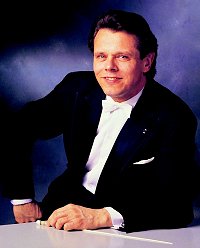S & H Concert Review
Mendelssohn, Haydn, Stravinsky, Vienna Philharmonic Orchestra, Mariss Jansons, RFH, 16th September 2002 (MB)
Mendelssohn, Strauss, Vienna Philharmonic Orchestra, Christian Thielemann, RFH, 17th September 2002 (MB)
The Vienna Philharmonic’s first concert of the 2002-2003 London orchestral season, under the masterful direction of Mariss Jansons, produced one minor miracle in the orchestra’s second encore – the ‘Death of Tybalt’ from Prokofiev’s Romeo & Juliet. Played with inexorable power it left a shattering impact. Jansons delved deep into this orchestra’s considerable reserves to summon playing of sublime violence and vivid imagery; with rapier-like precision the impression was of conductor and orchestra in a manic duel to the death. Their first encore of Dvorak’s Op.72 Slavonic Dance, No. 7, showed the extraordinary colour for which this orchestra is unrivalled.The sumptuousness of the VPO’s string tone brought both dividends and problems in Mendelssohn’s ‘Scottish’ Symphony: Dividends in the spaciousness it gave to the opening movement, problems in the heaviness of the vivace second movement. Woodwind were notably edgy and acerbic (that infamous vinegary tone), especially in the flutes, yet there is no denying the power of the conception Jansons brought to the symphony, inappropriate as some of it might have sounded. Haydn’s 97th Symphony, with the orchestra scaled down in this performance, had a scintillating electricity, but was again rather too pronounced in its gravity. Few orchestras with this breadth of sound, however, play Haydn with such transparency.
It was left to the 1919 Suite from the Firebird to show what glories this orchestra is capable of in terms of spinning colour. Much more gripping – and far better played - than a Proms Firebird this year it still feels anathematic to hear this orchestra, civilized to the hilt, play any Stravinsky, even Stravinsky which is broadly conservative in tone. Kashchei’s Infernal Dance had barely suppressed menace, yet Jansons succeeded in bringing out the power of the piece. Trenchant brass, not always well focussed, burned brightly.
Christian Thielemann’s concert with the Vienna Philharmonic showed both this orchestra and conductor at their best, although only unquestionably in Strauss’s epic Ein Heldenleben. Thielemann, unlike Jansons, makes the pregnancy between his beat and the orchestra’s entry dynamically broad (some might say excessively so). The result is a thrilling saturation of string tone and this was heard to no better effect than in the opening of the work. For purists, this was as authentic a Viennese sound as you will hear today.
Yet, Thielemann divides opinion in an unhealthy way amongst critics. Many simply do not see the trees for the wood – a review of this very concert in the London Evening Standard so clearly illustrates the point and Mr Hunt’s review is only useful for reminding us that some critics literally are deaf. Is it that Thielemann is unfashionable compared with, say, Simon Rattle, the echt modern day baton wielder? In part the answer is yes: Thielemann, trained the hard way through opera houses, brings a weighty, Germanic repose to everything he conducts (has Schoenberg ever sounded so Wagnerian?). His is very much of a style firmly from the past. Yet, this is partly to miss the point about him. What he brings to Ein Heldenleben (and much else besides) is an operatic conductor’s ability to tease out the clotted textures and clarify the counterpoint. The final section of Ein Heldenleben, for example, is both feverish and conciliatory and yet rarely have I encountered in this movement such intelligent understanding of it’s diaphanous colouring – from a kettle drum toned like a heart beat through to the heavenly – almost celestial – trumpets, perfectly integrated with restrained yet noble strings. The contrast he made between tremolo violins against the sweeping drama of the horns, ‘celli and double basses near the close of the work (fig. 105) – with every crescendo and every diminuendo assimilated and played – was visionary. Much of this performance was astonishing for the way Thielemann made it seem light and capricious against a sumptuous backdrop of sound which in lesser hands would have just sounded unbearably heavy. Often, audiences are used to hearing the overwhelming contrapuntalism of the work at the expense of all else. What we were hearing in this performance was a rare attempt to tease out the polyphony.
For much of the performance the playing of the Vienna Philharmonic was full of drama and colour – and no player emphasised this more than the concertmaster, Rainer Honeck, who played his demanding violin solos with supreme virtuosity. The Berliner Philharmoniker would undoubtedly have played the work with greater virtuosity and cleaner articulation, yet no orchestra except the Vienna Philharmonic can make this work sound so Straussian.
Neither Mendelssohn’s overture to a Midsummer Night’s Dream nor the inflated Fantasie from Die Frau Ohne Schatten were on a similar level of achievement. In the former, Thielemann succumbed to rather heavy treatment of a work which is largely fantasy; in the latter he merely made one regret we were not hearing the complete score. An encore, of the Mondschein music from Capriccio, shimmered.
Marc Bridle

 Return to:
Return to: